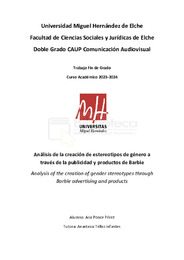Please use this identifier to cite or link to this item:
https://hdl.handle.net/11000/33495Full metadata record
| DC Field | Value | Language |
|---|---|---|
| dc.contributor.advisor | Téllez Infantes, Anastasia | - |
| dc.contributor.author | Ponce Pérez, Ana | - |
| dc.contributor.other | Departamentos de la UMH::Ciencias Sociales y Humanas | es_ES |
| dc.date.accessioned | 2024-10-15T09:22:28Z | - |
| dc.date.available | 2024-10-15T09:22:28Z | - |
| dc.date.created | 2024-06 | - |
| dc.identifier.uri | https://hdl.handle.net/11000/33495 | - |
| dc.description.abstract | La publicidad es una herramienta indispensable en la actualidad para dar a conocer cualquier producto, servicio o idea a un consumidor o consumidora objetivo. Además, la publicidad puede influenciar a grupos de ciertas edades como son los niños y las niñas creando ideas a través de anuncios. El presente trabajo de investigación tiene como objetivo principal llevar a cabo un análisis de la influencia de la publicidad a la hora de crear estereotipos de género, pero, sobre todo, a través de la muñeca más famosa de todos los tiempos: Barbie. En este estudio se puede observar que, a través de la publicidad, se pueden contemplar ciertos estereotipos de género de décadas pasadas pero que, hoy en día continúan existiendo. Por ejemplo, hasta hace poco, los anuncios televisivos de productos de limpieza para el hogar eran protagonizados solo por mujeres1. Con respecto a esto, ¿se podría decir que Barbie ha contribuido en la construcción de estereotipos de género? Barbie fue lanzada a finales de los años 50 del pasado siglo en California, Estados Unidos, por Ruth Handler con el objetivo de proporcionar a su hija un juguete con imagen de mujer independiente y así alejarla de los tradicionales muñecos bebés a los que cuidar como si se tratase de una madre y no de una niña pequeña. Barbie se ha convertido desde entonces en un icono cultural tanto del siglo XX como del XXI en países de Occidente donde se considera bello una piel blanca, cuerpo delgado y estilizado, ojos grandes y claros, melena arreglada, etc. Personajes como Barbie presidenta, astronauta, abogada, doctora… demuestran su capacidad para ayudar a la creatividad. Más allá de la meritocracia, Barbie refleja la evolución de las necesidades e identidades de las mujeres. Por último, en las conclusiones se exponen las reflexiones sobre la influencia de la publicidad y sobre todo de la imagen que proyecta Barbie sobre las niñas y niños en cuanto a la idea preconcebida de lo que es la belleza. Cabe mencionar que, a continuación, en el presente trabajo, se va a emplear un lenguaje masculino ya que, según la RAE es un lenguaje inclusivo. | es_ES |
| dc.description.abstract | Advertising is an indispensable tool in today’s world for introducing any product, service, or idea to a target consumer. Furthermore, advertising can influence specific age groups, such as children, by shaping ideas through advertisements. The main objective of this research project is to analyze the impact of advertising in creating gender stereotypes, particularly through the lens of the most iconic doll of all time: Barbie. Through this study, we observe that advertising often portrays ambiguous representations that persist in relation to gender stereotypes. For instance, until recently, television commercials for household cleaning products exclusively featured women. Regarding this, can we assert that Barbie has contributed to the construction of gender stereotypes? Barbie was launched in the late 1950s in California, United States, by Ruth Handler with the aim of providing her daughter with a toy that portrayed an independent woman, thus steering her away from traditional baby dolls that needed caring for as if she were a mother rather than a little girl. Since then, Barbie has become a cultural icon of both the 20th and 21st centuries in Western countries, where beauty is considered to be fair skin, a slim and stylized body, large and light eyes, well-groomed hair, etc. Characters like Barbie as president, astronaut, lawyer, doctor, and more demonstrate her ability to inspire creativity. Beyond meritocracy, Barbie reflects the evolving needs and identities of women. Lastly, the conclusions present reflections on the influence of advertising and especially on the image that Barbie projects onto girls and boys regarding the preconceived idea of beauty. It should be noted that in this work, masculine language will be used as, according to the RAE, it is considered inclusive language. | es_ES |
| dc.format | application/pdf | es_ES |
| dc.format.extent | 44 | es_ES |
| dc.language.iso | spa | es_ES |
| dc.publisher | Universidad Miguel Hernández de Elche | es_ES |
| dc.rights | info:eu-repo/semantics/openAccess | es_ES |
| dc.rights | Attribution-NonCommercial-NoDerivatives 4.0 Internacional | * |
| dc.rights.uri | http://creativecommons.org/licenses/by-nc-nd/4.0/ | * |
| dc.subject | Anuncios | es_ES |
| dc.subject | Barbie | es_ES |
| dc.subject | consumidor | es_ES |
| dc.subject | estereotipos | es_ES |
| dc.subject | género | es_ES |
| dc.subject | Advertisements | es_ES |
| dc.subject | consumer | es_ES |
| dc.subject | stereotypes | es_ES |
| dc.subject | gender | es_ES |
| dc.subject.other | CDU::7 - Bellas artes::77 - Fotografía. Cinematografía | es_ES |
| dc.title | Análisis de la creación de estereotipos de género a través de la publicidad y productos de Barbie | es_ES |
| dc.type | info:eu-repo/semantics/bachelorThesis | es_ES |

View/Open:
CAU_TFG_PONCE_PEREZ_ANA.pdf
979,72 kB
Adobe PDF
Share:
.png)
